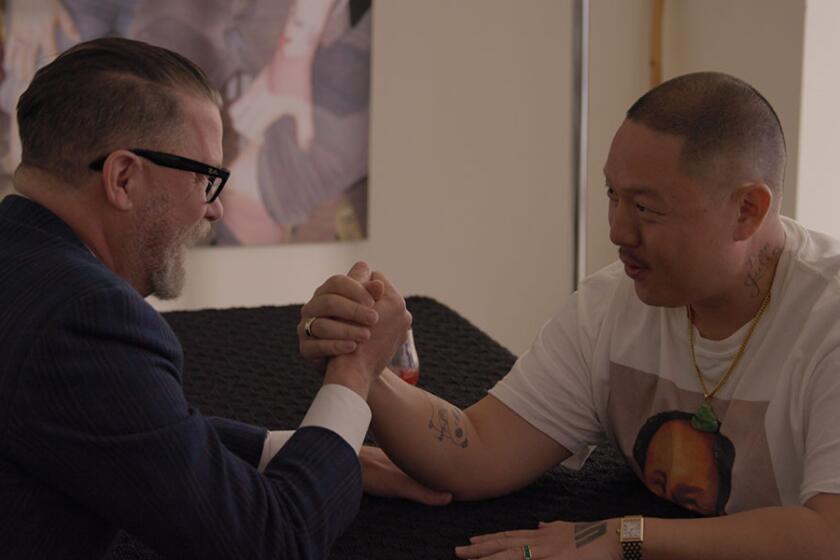Review: ‘American Factory’ manufactures insight into U.S.-Chinese collaboration
“American Factory” doesn’t sound glamorous, and it’s theoretically possible to portray its narrative as a simplistic tale of put-upon workers going toe to toe with grasping capitalists. But it’s not.
As directed by the veteran team of Steven Bognar and Julia Reichert, what we have instead is a complicated, multifaceted story that deals with very different cultures in combination and collision, a story that both understands global economic issues and has the sensitivity to involve us intimately in the daily lives of the people involved.
Bognar and Reichart, with three Oscar-nominated films between them, invariably focus on social issues and individuals’ desires to have better lives, but what makes “American Factory” different is that the Chinese have joined the party.
For in 2014, a huge plant in Dayton, Ohio, that General Motors had closed in 2008 was reopened as an automotive glass factory by Fuyao, a Chinese firm that, with clients such as Ford, GM, Honda and Toyota, controlled 70% of that market worldwide.
Spearheaded by Cao Dewang, Fuyao’s ambitious billionaire founder and chief executive, the move to Ohio was motivated by interlocking desires to increase visibility and possibly do some good in the world while simultaneously making as much money as possible.
Dubbed Chairman Cao by the filmmakers, Fuyao’s leader liked the idea of documentarians recording this singular endeavor, which is how Bognar and Reichert got three years of exceptional access, from the boardroom to the factory floor, that makes this such a potent documentary.
The directors also almost immediately made the shrewd decision to hire a pair of Chinese producers, Mijie Li and Yiqian Zhang, who did in-depth, personal interviews with some of the Chinese workers who relocated to Dayton to help the new factory get off the ground.
What gets revealed on screen is that the Chinese coming to Dayton did not work out the way anyone foresaw, and detailing how and why the situation gradually unraveled is shown in empathetic detail.
One thing that “American Factory” makes clear is that both the Chinese and Americans went into this with the best intentions, with U.S. workers desperately needing jobs after the GM closing and the new owners happy to provide employment, albeit at a lower wage that before.
The plan on the ground was that after the investment of half a billion dollars and the hiring of 2,000 workers, Chinese and American employees would be paired, with the Americans learning by doing and the Chinese, who’d left families behind to move to Dayton, doing the supervising.
Sometimes, these teammates became friends, as was the case with veteran Chinese furnace supervisor Wong He, who works so hard that hurriedly consumed Twinkies are his entire lunch, and his American counterpart, Rob Haerr.
But more often than not cultural dissonance was the result, especially when profits were not immediately forthcoming and both sides searched for the reason.
Filmmakers Julia Reichert and Steve Bognar made “American Factory” about an Ohio factory taken over by a Chinese company, and then Barack and Michelle Obama signed to produce on via Netflix.
One thing that couldn’t be clearer as we read the subtitles under candid conversations the Chinese have with each other is that a tendency to be patronizing toward Americans is never far from the surface.
“They are very obvious, they dislike abstraction and theory,” one supervisor says, while another complains “they have fat fingers, they are pretty slow.” The overall verdict: “We are better than them.”
What comes increasingly into focus as time goes by is that Americans and Chinese have very different ideas about the nature of work, of what sacrifices do or do not need to be made if you have a job.
The Chinese, for instance, accept regimentation while Americans cling to individuality, and Chinese are heard griping to their supervisors that Americans can’t be forced to work overtime.
Both sides had different plans for resolving this dilemma, with the Chinese sending key American personnel to Fuyao’s mainland mother ship to witness firsthand things like elaborate morale-building musical productions.
The American workforce, by contrast, worried about what it perceived as the company’s cavalier attitude toward safety and got in touch with the United Auto Workers union to organize the plant.
Chairman Cao viewed this prospect with horror and a showdown vote became inevitable. As furnace supervisor Wong put it, quoting a Chinese proverb, “one mountain cannot contain two tigers.”
One of the provocative ironies of “American Factory” is that by its close global economic realities like automation end up threatening all workers no matter where they come from or what their attitudes toward a union are.
The real world is not a just or simple place, this thorough, compelling documentary points out, no matter how deeply we may wish it were.
'American Factory'
Not rated
Running time: 1 hour, 50 minutes
Playing: Begins Wednesday at the Landmark, West Los Angeles; also on Netflix
More to Read
Only good movies
Get the Indie Focus newsletter, Mark Olsen's weekly guide to the world of cinema.
You may occasionally receive promotional content from the Los Angeles Times.












